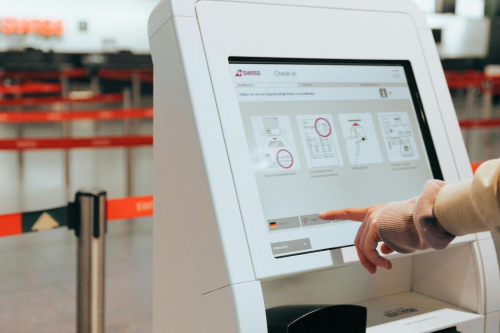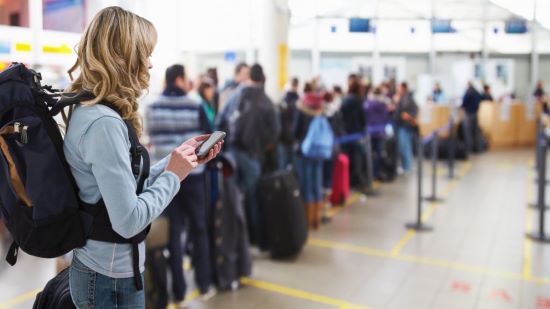Airport Check-In Kiosk: Usages and How to Use
Airport check-in kiosks have many uses. Passengers can check-in, choose different flight options, and even change their itinerary.
Even though airport check-in kiosks have existed since the 2000s, many people still opt for the traditional check-in counter.
The biggest reason is that they are uncertain what these kiosks can do and how to use them.
To provide valuable market education, we have compiled this information here.
Part 1. Usages for Self-service Kiosk Airport
Though these devices are often referred to as airport check-in kiosks, they actually have a much broader range of functionalities than their name suggests.

Source: Pexels
- Flight check-in - This is the most obvious use case. Passengers must manually input their information or scan a barcode if the kiosk has an appropriate reader to check in.
- Passenger preferences - Some kiosks will enable passengers to customize their flight by choosing seat preferences, meal plans, and other upgrades, such as lounge access, priority boarding, or extra baggage.
- Flight changes - Some kiosks can also handle flight adjustments, such as canceling, rebooking, or rescheduling.
- Flight information - These kiosks can also serve as a clearinghouse for information about the airline's flights and schedule, enabling passengers to plan better.
Part 2. How to Use an Airport Check-in Kiosk
- Find the right kiosk - Kiosks are not universal: They are typically segmented by airline. Passengers should look for the kiosk belonging to their airline, which is usually indicated by company branding on the hardware, such as a logo on the side.
- Check in - Passengers should then use the kiosk to check in. Some kiosks may require inputting information via a keyboard or touch screen, while others may operate by scanning a barcode on their ticket. Follow your kiosk's directions carefully.
- Confirm successful check-in - On some kiosks, successful check-in is obvious: It will print a boarding pass. Others, however, are entirely paperless: They will often email you your boarding pass. If the latter, check to make sure that you received it.
- Make other necessary changes - Some passengers may want to upgrade their seating, choose different meals, or check in additional baggage. Navigate to these respective options and make your choices accordingly.
- Double-check screen - Upon completing their check-in and any other changes, passengers should ensure that the software exists from the personal information screens. This check ensures that the passenger will not lose personal information to data thieves.
Part 3. Benefits of Using Airport Check-in Kiosk
When airlines implement airport check-in kiosks, they gain several immediate advantages.
Improvement of the passenger experience
Most passengers have a negative association with flying. They may think of the long lines and waiting, the great distances they'll have to carry their luggage or the invasive security checkpoints.
While it would be impossible to completely revamp airports as we know them today, installing airport check-in kiosks enhances the passenger experience.
The most obvious benefit is that passengers are spared from waiting in the often excruciatingly long lines for the check-in counter.
This benefit, however, has a cascading impact on the rest of their stay. They can spend more time relaxing before their flight, such as shopping, dining, or saying goodbye to loved ones in the waiting area.
Some airports even have attractions on their own, such as Singapore's Jewel Changi Airport, which has the world's tallest indoor waterfall—passengers are now freer to explore these.
Overall, airport check-in kiosks kickstart a positive passenger experience that lasts until the person boards their plane and takes off the runway.

Free up airline staff
Long queues at the check-in counter are also a visible measure of opportunity cost. Every minute that the employee spends checking in a passenger is one that they cannot spend on other higher-value activities.
Adding airport check-in kiosks frees up their time. Freed from the routine work of checking people in, employees can focus on more critical tasks.
For example, they can focus on checking in passengers who genuinely need assistance, such as the differently abled or small children traveling without guardians. They can also resolve complex issues, such as lost baggage, with greater focus and speed.
These employees can also be allocated to more critical functions. For example, some flights will have VIP passengers. With the typical boarding process in place, employees could only spend the bare minimum with these VIPs.
With airport check-in kiosks available, employees can dedicate time to upsell or cross-sell these VIPs with additional services, such as special in-flight meals or lounge access, that generate revenue for the company.
Airport check-in kiosks enable employees to pursue the work that matters the most.
Ease of making additional last-minute changes
People are only willing to go through the process once when checking in at check-in counters. This approach is problematic because people will sometimes want to make changes.
For example, a vegetarian passenger may have booked the wrong meal; another may want to upgrade his seat once he realizes that his company has a greater travel allowance, and one might wish to move his flight to one available earlier.
Despite these preferences, these passengers may not be willing to wait another hour or two in a check-in line. They would have to suffer and endure their current choices. However, If airport check-in kiosks were available, they could update their flight details and other preferences as needed.
The vegetarian can change his meal preferences to the correct one, the business traveler can upgrade to first class, and the other passenger can move to an earlier flight to the same destination. With airport check-in kiosks, passengers get a more responsive and agile flight experience.
Enhancing Airline Kiosk Reliability with MDM Solution
Sometimes, kiosks are subject to problems. They can glitch or go offline, and they are also susceptible to defacement and hacks. Airlines can maximize the uptime of their kiosks with an MDM like AirDroid Business, which is equipped with remote access and control and the ability to lock down devices. With an MDM, kiosks deliver on the promise of elevating the passenger experience to new heights.
Part 4. Dealing with Technical Issues on Airport Check-in Kiosks
As with any technology, airport check-in kiosks are prone to issues. They may go offline, freeze, or glitch. While these issues may be inconvenient elsewhere, they are especially problematic in an airport setting.
Why technical issues are doubly bad
When airlines have airport check-in kiosks, they usually advertise this fact. Their passengers will adjust their behavior in kind. Instead of budgeting enough time to go through a queue for the check-in counter, they may allocate significantly less time.
Once they go to the airport and find that the airline's kiosks are out of order, they will still have to go through manual check-in, only now they have even less time to wait in the queue. This will make them even more stressed and disappointed in the airline and increase their chances of missing their boarding.
How to mitigate technical issues with self-service kiosk airport
The operative word here is mitigate because it would be impossible to completely prevent the occurrence of any technical issue. The key is to find them as early as possible so that airlines can minimize downtime.
Unfortunately, most check-in software is uploaded locally, so airline staff must manually monitor kiosks. This monitoring will result in longer downtimes because airline staff operate in a fast-paced environment where such details will inevitably be overlooked.
Fortunately, airlines have a better option through an MDM like AirDroid Business. With an MDM, an airline's IT staff can remotely monitor their kiosks, and setup alerts to detect abnormal kiosk behaviors.
When the IT staff notices an issue with a kiosk, he can also fix it through remote control, even if the device is unattended. To enhance security during this remote troubleshooting, the IT staff can even initiate black screen mode so that no third party will be privy to the organization's inner workings. Once finished, he can exit black screen mode and restore the device to general use.
With an MDM, airlines can maximize the uptime of their airport check-in kiosks, enhancing the passenger experience.
Part 5. Dealing with Potential Abuses of Airport Check-in Kiosks
The vast majority of passengers will treat the airport check-in kiosks with respect. They will check in, input their required details, make their desired selections, and move on. A minority of bad actors, however, may use these kiosks in nefarious ways.
Types of abuses with self check-in airport
There are several ways that a passenger may abuse a kiosk.
- Unintended use - All kiosks are connected to the internet. As they are essentially large tablets, some passengers may use them by exiting the airline's app, surfing the net, or downloading another app.
- Defacement — Some passengers may leave vulgar content on the screen to offend other passengers. For example, a passenger may go to the browser, download an offensive image, and save it as the kiosk's wallpaper or screensaver.
- Data theft - Hackers masquerading as passengers may install malware to steal personal information. For example, they could create an app that resembles the one belonging to the airline to collect this sensitive information.
- Malware - Hackers may attempt to use the kiosks as an entry point to the rest of the airline's networks. As a device on the edge, these kiosks may be a particularly attractive, if not susceptible, attack vector.
Defending against kiosk abuses
All of these abuses share the same origin: access. When passengers can access other areas, such as web browsers or app stores, they can use the device for unauthorized or nefarious purposes. Cutting off this access is equivalent to defending against the vast majority of potential abuses.
The best way to lock down a device is through an MDM. For example, AirDroid Business has kiosk mode, which restricts usage to a single app. Any user cannot leave that app for other purposes. Because only the IT team can exit kiosk mode, airlines effectively stop abuses before they can start.
Part 6. Elevating the passenger experience with self check-in airport
Airport check-in kiosks are valuable additions for any airline. With these devices, passengers can more easily check in, pick different options and upgrades, and change their flight as needed. These use cases benefit both passengers, who get a best-in-class passenger experience, and the airlines, which free up employee time for more critical tasks.
Airport check-in kiosks are not a silver bullet on their own. As devices, they are prone to mishaps such as glitching and going offline. The human element also presents a curveball: Bad actors use these devices for unauthorized purposes such as web browsing, deface them, or even install malware.
To protect their investment in airport check-in kiosks, airlines should employ an MDM like AirDroid Business.
With an MDM, airlines can restore kiosks whenever they go offline through remote access and control. Kiosk mode also enables airlines to prevent issues that arise when passengers or bad actors exit the airline's app. Passengers, in turn, get to use the kiosks as intended and finally get the passenger experience they have long deserved.







Leave a Reply.